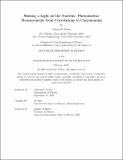Shining a Light on the Nucleus: Photonuclear Measurements from Correlations to Charmonium
Author(s)
Pybus, Jackson R.
DownloadThesis PDF (13.09Mb)
Advisor
Hen, Or
Terms of use
Metadata
Show full item recordAbstract
The atomic nucleus is comprised of a collection of nucleons (protons and neutrons), which are bound together by the nucleon-nucleon (NN) interaction that originates from Quantum Chromodynamics (QCD). While most nucleons experience the force from the rest of the nucleus as a single net “mean-field” interaction that binds them relatively weakly, a small but impactful fraction are in configurations called “Short-Range Correlations” (SRCs), in which they pair with another nucleon at very short distance to experience strong interactions, significant binding, and high momentum. Hard, high-energy scattering reactions in which an SRC pair is broken apart, knocking both nucleons out of the nucleus, provide the ability to probe the details of these SRC configurations in the nucleus. Previous measurements have had limited statistics and kinematic reach, and the theoretical tools available were insufficient to draw quantitative conclusions regarding the ground-state properties of SRCs. The studies described in this thesis represent the first global analysis of SRC breakup measurements in order to present a unified picture of SRCs within light- to medium-size nuclei. This includes the use of a novel theoretical framework, the Generalized Contact Formalism, which connects scattering cross-section measurements and the ground-state properties of the SRC pair, to quantitatively interpret a variety of electron-scattering measurements. This is brought to culmination by a report on the first measurement of SRC pairs via the use of hard meson photoproduction reactions, which, despite differing significantly from the mechanics of electron-scattering, is well-described under a common framework, pointing to a consistent and universal picture of SRCs across reaction channels. I also report on the first measurement of J/ψ photoproduction in the near- and below-threshold kinematic region, giving the first insights to the gluonic structure of bound nucleons in the large-x “valence” region and providing constraints on a gluonic “EMC effect”. In addition to these studies, I provide details on the search for Primakoff production of axion-like particles using the photoproduction data taken for this experiment, and I conclude by describing studies of nucleon spin structure measurements that will be performed at the forthcoming U.S. Electron-Ion Collider.
Date issued
2025-02Department
Massachusetts Institute of Technology. Department of PhysicsPublisher
Massachusetts Institute of Technology